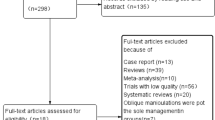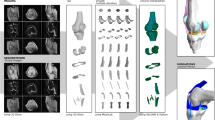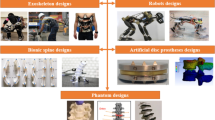Abstract
Purpose of Review
To summarize the recent advances in 3D printing technology as it relates to spine surgery and how it can be applied to minimally invasive spine surgery.
Recent Findings
Most early literature about 3D printing in spine surgery was focused on reconstructing biomodels based on patient imaging. These biomodels were used to simulate complex pathology preoperatively. The focus has shifted to guides, templates, and implants that can be used during surgery and are specific to patient anatomy. However, there continues to be a lack of long-term outcomes or cost-effectiveness analyses. 3D printing also has the potential to revolutionize tissue engineering applications in the search for the optimal scaffold material and structure to improve bone regeneration without the use of other grafting materials.
Summary
3D printing has many potential applications to minimally invasive spine surgery requiring more data for widespread adoption.







Similar content being viewed by others
References
Papers of particular interest, published recently, have been highlighted as: • Of importance •• Of major importance
Tack P, Victor J, Gemmel P, Annemans L. 3D-printing techniques in a medical setting: a systematic literature review. Biomed Eng Online. 2016;15(1):115. https://doi.org/10.1186/s12938-016-0236-4.
Fessler RG, Smith ZA, Slimack N, Smith JS, Parkinson RJ. Current advances and evidence in minimally invasive spine surgery. Minim Invasive Surg. 2012;2012:508415. https://doi.org/10.1155/2012/508415.
Lucio JC, Vanconia RB, Deluzio KJ, Lehmen JA, Rodgers JA, Rodgers W. Economics of less invasive spinal surgery: an analysis of hospital cost differences between open and minimally invasive instrumented spinal fusion procedures during the perioperative period. Risk Manage Healthcare Policy. 2012;5:65–74. https://doi.org/10.2147/rmhp.S30974.
Anderson PA. Clinical applications of 3D Printing. Spine. 2017;42(Suppl 7):S30–s1. https://doi.org/10.1097/brs.0000000000002039.
Zhang L, Yang G, Johnson BN, Jia X. Three-dimensional (3D) printed scaffold and material selection for bone repair. Acta Biomater. 2019;84:16–33. https://doi.org/10.1016/j.actbio.2018.11.039.
• D’Urso PS, Askin G, Earwaker JS, Merry GS, Thompson RG, Barker TM, et al. Spinal biomodeling. Spine. 1999;24(12):1247–51 First paper to describe 3DP in spine.
Garg B, Mehta N. Current status of 3D printing in spine surgery. Journal of clinical orthopaedics and trauma. 2018;9(3):218–25. https://doi.org/10.1016/j.jcot.2018.08.006.
Hsu MR, Haleem MS, Hsu W. 3D Printing applications in minimally invasive spine surgery. Minimally invasive surgery. 2018;2018:4760769. https://doi.org/10.1155/2018/4760769.
Wilcox B, Mobbs RJ, Wu AM, Phan K. Systematic review of 3D printing in spinal surgery: the current state of play. J Spine Surg (Hong Kong). 2017;3(3):433–43. https://doi.org/10.21037/jss.2017.09.01.
• Witowski J, Sitkowski M, Zuzak T, Coles-Black J, Chuen J, Major P, et al. From ideas to long-term studies: 3D printing clinical trials review. Int J Comput Assist Radiol Surg. 2018;13(9):1473–8. https://doi.org/10.1007/s11548-018-1793-8There was a surge of clinical trials using 3DP after 2015, with orthopaedic surgery being the most commonly utilized discipline. Most of the trials are still ongoing and are expected to be published within a few years. China is the leader in the number of clinical trials (45.65%) followed by the United States (14.13%).
U.S. Department of Health and Human Services. Food and Drug Administration. Center for Devices and Radiological Health. Center for Biologics Evaluation and Research. “Technical considerations for additive manufactured medical devices. Guidance for industry and Food and Drug administration staff.” 2017.
• Zhao W, Shen C, Cai R, Wu J, Zhuang Y, Cai Z, et al. Minimally invasive surgery for resection of ossification of the ligamentum flavum in the thoracic spine. Wideochirurgia i inne techniki maloinwazyjne = Videosurgery and other miniinvasive techniques. 2017;12(1):96–105. https://doi.org/10.5114/wiitm.2017.66473The authors used 3DP biomodels for preoperative planning and patient education for a novel, minimally invasive technique. They received positive patient interactions citing that the 3D biomodel aided understanding of the disease, the need for surgery, and provided reassurance. At a mean follow-up of 13.3 months, the authors concluded that the MIS resection technique was safe, had faster recovery, and had less muscle injury.
Liew Y, Beveridge E, Demetriades AK, Hughes MA. 3D printing of patient-specific anatomy: a tool to improve patient consent and enhance imaging interpretation by trainees. Br J Neurosurg. 2015;29(5):712–4. https://doi.org/10.3109/02688697.2015.1026799.
Zheng W, Chen C, Zhang C, Tao Z, Cai L. The feasibility of 3D printing technology on the treatment of pilon fracture and its effect on doctor-patient communication. Biomed Res Int. 2018;2018:8054698. https://doi.org/10.1155/2018/8054698.
Rehder R, Abd-El-Barr M, Hooten K, Weinstock P, Madsen JR, Cohen AR. The role of simulation in neurosurgery. Childs Nerv Syst. 2016;32(1):43–54. https://doi.org/10.1007/s00381-015-2923-z.
Park HJ, Wang C, Choi KH, Kim HN. Use of a life-size three-dimensional-printed spine model for pedicle screw instrumentation training. J Orthop Surg Res. 2018;13(1):86. https://doi.org/10.1186/s13018-018-0788-z.
Marconi S, Pugliese L, Botti M, Peri A, Cavazzi E, Latteri S, et al. Value of 3D printing for the comprehension of surgical anatomy. Surg Endosc. 2017;31(10):4102–10. https://doi.org/10.1007/s00464-017-5457-5.
Li Z, Li Z, Xu R, Li M, Li J, Liu Y, et al. Three-dimensional printing models improve understanding of spinal fracture--a randomized controlled study in China. Sci Rep. 2015;5:11570. https://doi.org/10.1038/srep11570.
Gottschalk MB, Yoon ST, Park DK, Rhee JM, Mitchell PM. Surgical training using three-dimensional simulation in placement of cervical lateral mass screws: a blinded randomized control trial. Spine J : official journal of the North American Spine Society. 2015;15(1):168–75. https://doi.org/10.1016/j.spinee.2014.08.444.
Smith ZA, Fessler RG. Paradigm changes in spine surgery: evolution of minimally invasive techniques. Nat Rev Neurol. 2012;8(8):443–50. https://doi.org/10.1038/nrneurol.2012.110.
Yamada T, Osako M, Uchimuro T, Yoon R, Morikawa T, Sugimoto M, et al. Three-dimensional printing of life-like models for simulation and training of minimally invasive cardiac surgery. Innovations (Philadelphia, Pa). 2017;12(6):459–65. https://doi.org/10.1097/imi.0000000000000423.
Weinstock P, Rehder R, Prabhu SP, Forbes PW, Roussin CJ, Cohen AR. Creation of a novel simulator for minimally invasive neurosurgery: fusion of 3D printing and special effects. J Neurosurg Pediatr. 2017;20(1):1–9. https://doi.org/10.3171/2017.1.Peds16568.
Barber SR, Kozin ED, Dedmon M, Lin BM, Lee K, Sinha S, et al. 3D-printed pediatric endoscopic ear surgery simulator for surgical training. Int J Pediatr Otorhinolaryngol. 2016;90:113–8. https://doi.org/10.1016/j.ijporl.2016.08.027.
Izatt MT, Thorpe PL, Thompson RG, D'Urso PS, Adam CJ, Earwaker JW, et al. The use of physical biomodelling in complex spinal surgery. Eur Spine J : official publication of the European Spine Society, the European Spinal Deformity Society, and the European Section of the Cervical Spine Research Society. 2007;16(9):1507–18. https://doi.org/10.1007/s00586-006-0289-3.
Yang M, Li C, Li Y, Zhao Y, Wei X, Zhang G, et al. Application of 3D rapid prototyping technology in posterior corrective surgery for Lenke 1 adolescent idiopathic scoliosis patients. Medicine. 2015;94(8):e582. https://doi.org/10.1097/md.0000000000000582.
Ling Q, He E, Ouyang H, Guo J, Yin Z, Huang W. Design of mulitlevel OLF approach ("V"-shaped decompressive laminoplasty) based on 3D printing technology. E Spine J: official publication of the European Spine Society, the European Spinal Deformity Society, and the European Section of the Cervical Spine Research Society. 2018;27(Suppl 3):323–9. https://doi.org/10.1007/s00586-017-5234-0.
• Thayaparan GK, Owbridge MG, Thompson RG, D’Urso PS. Designing patient-specific solutions using biomodelling and 3D-printing for revision lumbar spine surgery. Eur Spine J : official publication of the European Spine Society, the European Spinal Deformity Society, and the European Section of the Cervical Spine Research Society. 2018. https://doi.org/10.1007/s00586-018-5684-zFirst case report of 3DP used in minimally invasive revision lumbar surgery. A biomodel was used for preoperative planning, patient education, surgical simulation, and intraoperative reference. In addition, the authors made 3DP tools: drill guide, self-docking nylon tubular retractors, and titanium lumbosacral fixation implant with screws. At follow-up at 6 months, there was resolution of symptoms with no evidence of implant dysfunction. Although this is an encouraging report, there needs to be higher powered studies with longer follow-up to determine if the procedure is truly safe, effective, and cost-efficient.
Popescu D, Laptoiu D. Rapid prototyping for patient-specific surgical orthopaedics guides: a systematic literature review. Proc Inst Mech Eng H J Eng Med. 2016;230(6):495–515. https://doi.org/10.1177/0954411916636919.
Kim J, Rajadurai J, Choy WJ, Cassar L, Phan K, Harris L, et al. Three-dimensional patient-specific guides for intraoperative navigation for cortical screw trajectory pedicle fixation. World neurosurgery. 2019;122:674–9. https://doi.org/10.1016/j.wneu.2018.11.159.
Guo F, Dai J, Zhang J, Ma Y, Zhu G, Shen J, et al. Individualized 3D printing navigation template for pedicle screw fixation in upper cervical spine. PLoS One. 2017;12(2):e0171509. https://doi.org/10.1371/journal.pone.0171509.
Garg B, Gupta M, Singh M, Kalyanasundaram D. Outcome and safety analysis of 3D-printed patient-specific pedicle screw jigs for complex spinal deformities: a comparative study. Spine J: official journal of the North American Spine Society. 2019;19(1):56–64. https://doi.org/10.1016/j.spinee.2018.05.001.
Kaneyama S, Sugawara T, Sumi M. Safe and accurate midcervical pedicle screw insertion procedure with the patient-specific screw guide template system. Spine. 2015;40(6):E341–8. https://doi.org/10.1097/brs.0000000000000772.
D'Urso PS, Williamson OD, Thompson RG. Biomodeling as an aid to spinal instrumentation. Spine. 2005;30(24):2841–5.
Wu X, Liu R, Yu J, Lu L, Yang C, Shao Z, et al. Deviation analysis for C1/2 pedicle screw placement using a three-dimensional printed drilling guide. Proc Inst Mech Eng H J Eng Med. 2017;231(6):547–54. https://doi.org/10.1177/0954411916680382.
Li F, Huang X, Wang K, Luo B, Zhang F, Chen Z, et al. Preparation and assessment of an individualized navigation template for lower cervical anterior transpedicular screw insertion using a three-dimensional printing technique. Spine. 2018;43(6):E348–e56. https://doi.org/10.1097/brs.0000000000002341.
Yu Z, Zhang G, Chen X, Chen X, Wu C, Lin Y, et al. Application of a novel 3D drill template for cervical pedicle screw tunnel design: a cadaveric study. Eur Spine J: official publication of the European Spine Society, the European Spinal Deformity Society, and the European Section of the Cervical Spine Research Society. 2017;26(9):2348–56. https://doi.org/10.1007/s00586-017-5118-3.
Bundoc RC, Delgado GG, Grozman SA. A novel patient-specific drill guide template for pedicle screw insertion into the subaxial cervical spine utilizing stereolithographic modelling: an in vitro study. Asian Spine J. 2017;11(1):4–14. https://doi.org/10.4184/asj.2017.11.1.4.
• Thayaparan GK, Owbridge MG, Thompson RG, D'Urso PS. Designing patient-specific 3D printed devices for posterior atlantoaxial transarticular fixation surgery. J Clin Neurosci. 2018;56:192–8. https://doi.org/10.1016/j.jocn.2018.06.038Case series of 3 patients that used 3DP throughrout the surgical process to optimize outcomes and navigate safely around important anatomical structures in the atlantoaxial region. Using biomodels for preoperative planning and simulation, drill guides, and 3DP implants, they had no intraoperative complications with satisfactory imaging at 6 months and no implant failure at the 12 month follow-up. With this study, the authors show that the techniques can be applied throughout the spine and we expect that long-term outcomes from these patients will be evaluated in the future.
Liu K, Zhang Q, Li X, Zhao C, Quan X, Zhao R, et al. Preliminary application of a multi-level 3D printing drill guide template for pedicle screw placement in severe and rigid scoliosis. Eur Spine J : official publication of the European Spine Society, the European Spinal Deformity Society, and the European Section of the Cervical Spine Research Society. 2017;26(6):1684–9. https://doi.org/10.1007/s00586-016-4926-1.
Cecchinato R, Berjano P, Zerbi A, Damilano M, Redaelli A, Lamartina C. Pedicle screw insertion with patient-specific 3D-printed guides based on low-dose CT scan is more accurate than free-hand technique in spine deformity patients: a prospective, randomized clinical trial. Eur Spine J: official publication of the European Spine Society, the European Spinal Deformity Society, and the European Section of the Cervical Spine Research Society. 2019;28(7):1712–23. https://doi.org/10.1007/s00586-019-05978-3.
• Sugawara T, Kaneyama S, Higashiyama N, Tamura S, Endo T, Takabatake M, et al. Prospective multicenter study of a multistep screw insertion technique using patient-specific screw guide templates for the cervical and thoracic spine. Spine. 2018;43(23):1685–94. https://doi.org/10.1097/brs.0000000000002810This prospective multicenter study from Japan used the patient-specific, multi-step screw guide templates described in reference 32. The authors placed 813 screws in the cervical and thoracic spine with 98.5% of these screws placed without cortical violation or neurovascular injury. Interestingly, the authors also noted that their system was cost efficient at $4–20 per vertebral level. This is one promising system of numerous location, drill, and screw guide templates designed for various diseases and locations on the spine. However, the data is still in its infancy and there are no long-term outcome studies.
Feng ZH, Li XB, Phan K, Hu ZC, Zhang K, Zhao J, et al. Design of a 3D navigation template to guide the screw trajectory in spine: a step-by-step approach using Mimics and 3-Matic software. J Spine Surg (Hong Kong). 2018;4(3):645–53. https://doi.org/10.21037/jss.2018.08.02.
Xu N, Wei F, Liu X, Jiang L, Cai H, Li Z, et al. Reconstruction of the upper cervical spine using a personalized 3D-printed vertebral body in an adolescent with ewing sarcoma. Spine. 2016;41(1):E50–4. https://doi.org/10.1097/brs.0000000000001179.
Li X, Wang Y, Zhao Y, Liu J, Xiao S, Mao K. Multilevel 3D printing implant for reconstructing cervical spine with metastatic papillary thyroid carcinoma. Spine. 2017;42(22):E1326–e30. https://doi.org/10.1097/brs.0000000000002229.
Choy WJ, Mobbs RJ, Wilcox B, Phan S, Phan K, Sutterlin CE 3rd. Reconstruction of thoracic spine using a personalized 3D-printed vertebral body in adolescent with T9 primary bone tumor. World Neurosurgery. 2017;105:1032.e13–7. https://doi.org/10.1016/j.wneu.2017.05.133.
Phan K, Sgro A, Maharaj MM, D'Urso P, Mobbs RJ. Application of a 3D custom printed patient specific spinal implant for C1/2 arthrodesis. J Spine Surg (Hong Kong). 2016;2(4):314–8. https://doi.org/10.21037/jss.2016.12.06.
Lu T, Liu C, Yang B, Liu J, Zhang F, Wang D, et al. Single-level anterior cervical corpectomy and fusion using a new 3D-printed anatomy-adaptive titanium mesh cage for treatment of cervical spondylotic myelopathy and ossification of the posterior longitudinal ligament: a retrospective case series study. Med Sci Monit: international medical journal of experimental and clinical research. 2017;23:3105–14.
• Siu TL, Rogers JM, Lin K, Thompson R, Owbridge M. Custom-made titanium 3-dimensional printed interbody cages for treatment of osteoporotic fracture-related spinal deformity. World Neurosurg. 2018;111:1–5. https://doi.org/10.1016/j.wneu.2017.11.160This case report highlights the customizability of the the 3DP titanium cage that was able to correct deformity caused by osteoporotic fractures. The off-the-shelf implants would not correct the defomity adequately under a lateral MIS approach, but was achieveable with the customized implant.
MacBarb RF, Lindsey DP, Woods SA, Lalor PA, Gundanna MI, Yerby SA. Fortifying the bone-implant interface part 2: an in vivo evaluation of 3D-printed and TPS-coated triangular implants. Int J Spine Surg. 2017;11:16. https://doi.org/10.14444/4016.
McGilvray KC, Easley J, Seim HB, Regan D, Berven SH, Hsu WK, et al. Bony ingrowth potential of 3D-printed porous titanium alloy: a direct comparison of interbody cage materials in an in vivo ovine lumbar fusion model. Spine J: official journal of the North American Spine Society. 2018;18(7):1250–60. https://doi.org/10.1016/j.spinee.2018.02.018.
Jakus AE, Rutz AL, Jordan SW, Kannan A, Mitchell SM, Yun C, et al. Hyperelastic “bone”: a highly versatile, growth factor-free, osteoregenerative, scalable, and surgically friendly biomaterial. Sci Transl Med. 2016;8(358):358ra127. https://doi.org/10.1126/scitranslmed.aaf7704.
Yang Y, Chu L, Yang S, Zhang H, Qin L, Guillaume O, et al. Dual-functional 3D-printed composite scaffold for inhibiting bacterial infection and promoting bone regeneration in infected bone defect models. Acta Biomater. 2018;79:265–75. https://doi.org/10.1016/j.actbio.2018.08.015.
Ashammakhi N, Ahadian S, Pountos I, Hu SK, Tellisi N, Bandaru P, et al. In situ three-dimensional printing for reparative and regenerative therapy. Biomed Microdevices. 2019;21(2):42. https://doi.org/10.1007/s10544-019-0372-2.
Author information
Authors and Affiliations
Contributions
All of the authors contributed significantly to the development of this manuscript through data analysis, manuscript preparation, or analysis and editing of final manuscript.
Corresponding author
Ethics declarations
Conflicts of Interest
The authors declare that they have no conflict of interest.
Human and Animal Rights and Informed Consent
This article does not contain any studies with human or animal subjects performed by any of the authors.
Additional information
Publisher’s note
Springer Nature remains neutral with regard to jurisdictional claims in published maps and institutional affiliations.
This article is part of the Topical Collection on Minimally Invasive Spine Surgery
Rights and permissions
About this article
Cite this article
Yamaguchi, J.T., Hsu, W.K. Three-Dimensional Printing in Minimally Invasive Spine Surgery. Curr Rev Musculoskelet Med 12, 425–435 (2019). https://doi.org/10.1007/s12178-019-09576-0
Published:
Issue Date:
DOI: https://doi.org/10.1007/s12178-019-09576-0




